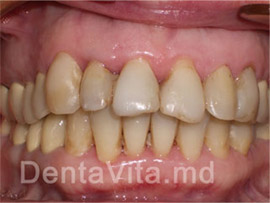We treat Teeth
We make art-restoring
videoTooth art-restoration ("building-up teeth") is able to make the patients’ smile not only like it once was but also what they want it to be.
Dentistry has gradually turned from job into art. A short time ago, dentists were primarily occupied with treatment. However, today the natural wish of people to become more beautiful forces them to make higher aesthetic demands to dental treatment, so the dentists have to do more subtle, almost jeweler's work. Before the tooth crown in the mouth of the patient has been modeled, the dentist must make an accurate work calculation because all the details matter.
The art restoration is specific because of the fact that the teeth being restored by this way are minimally dissected. That is to say, only nonviable tissue in the defect area is removed. For example, in order to put an artificial crown, the dentist has to grind the tooth surface, and sometimes, according to the medical evidence, the pulp has to be removed. In many cases, art restoration allows to keep the teeth "alive". The restoration method is more merciful towards the tooth. It also has more acceptable price, as the smile restoration in this way is dramatically cheaper than with crowns. In addition, this method allows to reduce visits to the dentist.


Art restoration ("building-up teeth") allows you to:
- not only to eliminate the signs of decay on your front teeth, but also to restore the complex anatomical form of chewing teeth;
- conceal the enamel defects (for example, the erosion of enamel or wedge-shaped defect);
- regain the tooth lost due to injury or fracture tooth, restoring its original colour, shine and the uniqueness of its shape.
Today, it is possible to restore a lost tooth from a "non-being", even if it there is only its root.
In addition, art-restoration is able to change the teeth shape (for example, to make them wider or, conversely, narrow, to shorten or to lengthen them). Owing to this method, you can get rid of the gaps between the teeth. Furthermore, the tooth edge is known to erase with the age, so the elongation of incisors by 1-2 mm will help to “rejuvenate” visually. Also, using this method, you can improve the tooth position (pushing it forward, or, just the opposite, removing the in depth) or change the colour of the tooth, if other methods of whitening are contraindicated. This is necessary if one of the teeth (or even several) has become different in colour from the neighbouring, which often happens after a poor sealing, medication (for example, tetracycline teeth) or due to hormonal changes. But you should not think that the restoration is a replacement to orthopedic or orthodontic treatment. Today, these three directions in dentistry "work" together for the patient’s benefit.
The artistic restoration can be performed in two ways: direct and indirect.
- The direct restoration is performed right in the patient’s mouth. When applying layer upon layer of the light-hardening nano-composite or composite material (each layer is no more than 2 mm), the dentist-restorer models the new tooth right on the spot.
- Indirect art restoration technique involves making veneers in a special laboratory. A veneer is a facing plate fixed with special cement (as a gel) to the patient’s tooth front surface.
Indirect restoration can be performed both from light-hardening materials, and from solid ceramics. The use of ceramics for dental restorations right in the patient’s mouth is impossible.
These and other technologies are used in the dental centre “Denta Vita” located in the centre of Chisinau, where our qualified dentists take advantage of all their experience with the help of the up-to-date equipment for our patients’ benefit.

















